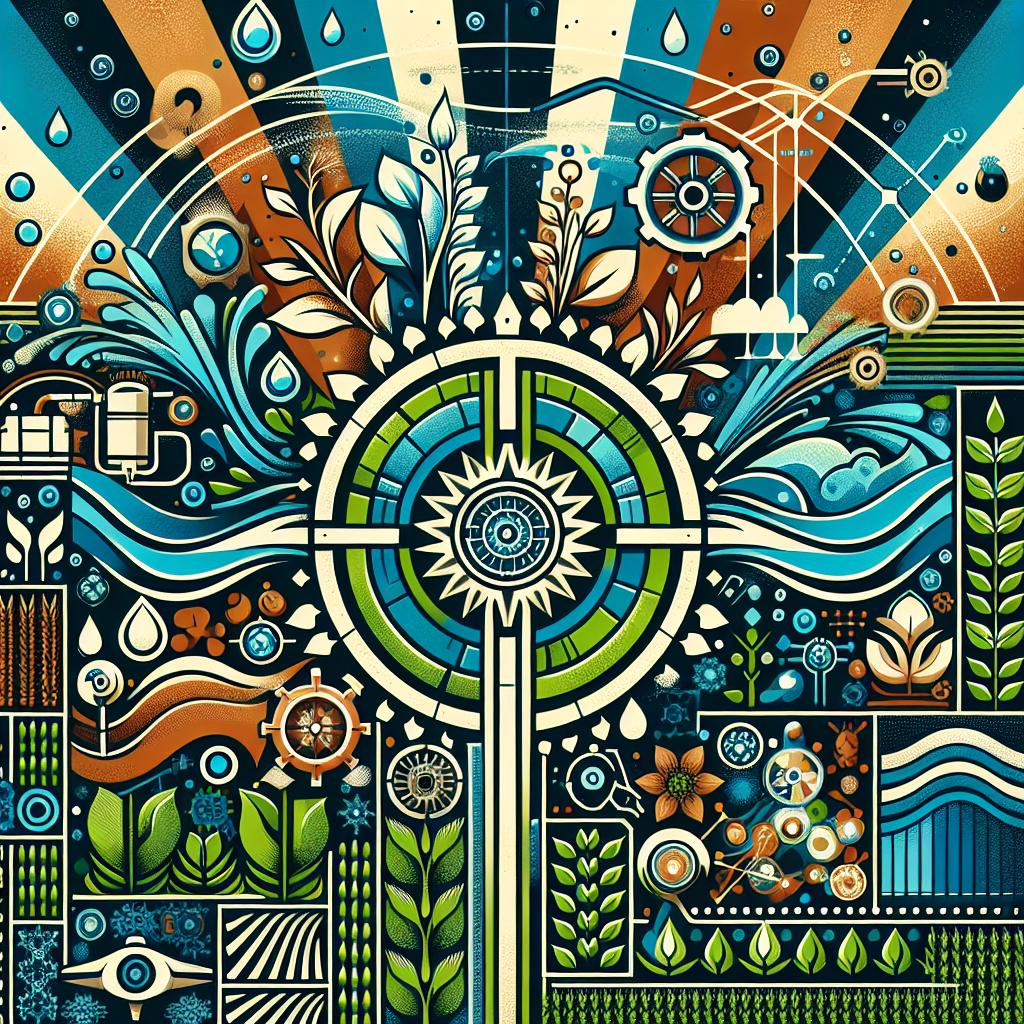This post may contain affiliate links which means I may receive a commission for purchases made through links. Learn more on my Private Policy page.
Exploring the Different Methods of Irrigating Crops: A Gardener’s Guide to Nourishing Nature
Welcome, fellow green thumbs and curious minds! Whether you’re a seasoned farmer, a backyard gardener, or simply someone who loves the sight of flourishing plants, you know one fundamental truth: water is life. As the sun generously shines down on our fields and gardens, the role of irrigation becomes ever more pivotal in ensuring our crops thrive in harmony with nature. But did you know that there’s a world of innovative methods to get that essential lifeblood flowing to your beloved plants? From traditional practices passed down through generations to cutting-edge technologies that make water conservation a breeze, this article will journey through the rich tapestry of irrigation techniques. So grab your watering can, roll up your sleeves, and let’s dive into the fascinating world of crop irrigation—because every plant deserves a drink!
Understanding the Basics of Crop Irrigation Techniques
Effective crop irrigation is essential for optimizing agricultural productivity, and understanding various techniques can significantly improve crop yield and sustainability. Each method has its own set of advantages and challenges, which can be tailored to specific crops and environmental conditions. Here are some widely used irrigation techniques:
- Drip Irrigation: A highly efficient method that delivers water directly to the root zone of plants, reducing evaporation and soil runoff.
- Sprinkler Irrigation: Employs a system of pipes and pumps to distribute water in the form of droplets over a large area, mimicking natural rainfall.
- Surface Irrigation: This traditional technique involves letting water flow over the soil surface, relying on gravity to reach the plants.
- Subsurface Irrigation: Involves burying irrigation lines below the soil surface, ensuring water reaches the roots while limiting evaporation.
Choosing the right irrigation method often depends on factors like soil type, crop requirements, and local climate. For instance, while drip irrigation is ideal for arid regions where water conservation is critical, sprinkler irrigation may be beneficial for crops requiring moisture during specific growth stages. Below is a brief comparison of the techniques:
| Irrigation Method | Water Efficiency | Initial Cost | Maintenance |
|---|---|---|---|
| Drip Irrigation | High | Medium | Low |
| Sprinkler Irrigation | Moderate | Medium | Medium |
| Surface Irrigation | Low | Low | High |
| Subsurface Irrigation | High | High | Medium |

Harnessing the Power of Drip Irrigation for Water Efficiency
Drip irrigation is a method that delivers water directly to the root zone of plants, utilizing a system of tubes, valves, and emitters. This precision ensures that each plant receives the exact amount of water it needs, minimizing wastage and enhancing growth. The advantages of this technique are numerous:
- Water Savings: Drip irrigation reduces evaporation, ensuring that more water reaches the plants.
- Reduced Weed Growth: With water directed to the roots, neighboring weeds often remain dry and unwatered.
- Soil Health: The slow application keeps the soil moist and promotes better soil structure.
- Versatility: It can be tailored to different crops, terrains, and climates, making it suitable for diverse agricultural settings.
Moreover, implementing drip irrigation can significantly improve the yield and quality of crops. Farmers can monitor the moisture levels in real-time, making adjustments based on data rather than guesswork. This allows for smarter irrigation practices and the ability to utilize a range of water sources efficiently. Here’s a quick comparison of traditional irrigation versus drip irrigation:
| Feature | Traditional Irrigation | Drip Irrigation |
|---|---|---|
| Water Usage | Higher | Lower |
| Risk of Disease | Higher | Lower |
| Setup Cost | Lower | Higher |
| Maintenance | Moderate | Minimal |

Exploring the Benefits of Sprinkler Systems in Diverse Climates
Sprinkler systems are a versatile solution for irrigation, offering several advantages that vary by climate. In arid regions, where water conservation is crucial, these systems can be finely tuned to deliver precise amounts of moisture, minimizing waste and ensuring that crops receive just what they need to thrive. Adjustable sprinkler heads allow farmers to customize the spray patterns, making it easier to water specific areas of a field without oversaturation. This adaptability is especially valuable in climates characterized by both extreme heat and sporadic rainfall, as it promotes healthy soil moisture levels while reducing evaporation losses.
In areas with wetter conditions, the installation of a sprinkler system can help to combat issues of soil erosion and waterlogging. By regulating the delivery of water, farmers can maintain optimal soil structure and promote healthy root development. Among the numerous benefits, sprinkler systems also facilitate the use of fertigation, where fertilizers are mixed with irrigation water, ensuring that nutrients are evenly distributed. The table below outlines some key advantages of sprinkler systems across different climates:
| Climate Type | Benefits of Sprinkler Systems |
|---|---|
| Arid |
|
| Humid |
|

Innovative Approaches to Soil Moisture Management for Thriving Harvests
As the quest for sustainable agriculture intensifies, innovative techniques for managing soil moisture are emerging as vital components for cultivating robust harvests. Farmers are increasingly turning to methods that not only conserve water but also enhance soil health. Techniques such as drip irrigation, which delivers water directly to the root zone, and rainwater harvesting, which captures and stores precipitation, are becoming popular. These methods help reduce evaporation losses and ensure that crops receive the necessary moisture during critical growth phases, resulting in increased yields and healthier plants. Additionally, cover cropping plays a crucial role by maintaining soil structure, enhancing moisture retention, and preventing erosion during off-seasons.
Further innovations in technology, such as soil moisture sensors and automated irrigation systems, provide real-time data to optimize water application. With these advancements, farmers can make informed decisions about when and how much to irrigate, minimizing waste and improving efficiency. Another exciting development is the use of soil amendments like biochar and compost, which improve soil’s water-holding capacity and nutrient availability. Together, these practices form a sustainable framework that not only supports thriving harvests today but also ensures the resilience of agricultural systems in the face of climate change.
In Retrospect
As we conclude our journey through the verdant world of irrigation methods, we hope you’ve unearthed a treasure trove of knowledge that will not only deepen your appreciation for the art and science behind feeding the world but also inspire your own agricultural endeavors, whether big or small. From the gentle embrace of drip irrigation to the rhythmic dance of flood systems, each method holds its own unique charm and advantages, tailored to the whispers of the land and the needs of the crops.
As you step into the fields of possibility, remember that understanding these techniques is just the beginning. Embrace innovation, experiment with different approaches, and foster a sustainable relationship with nature. The future of farming is rich with promise—one where water is wisely managed, crops flourish, and our planet nurtures us in return.
So, whether you’re a seasoned farmer, an avid gardener, or simply someone intrigued by the wonders of agriculture, let this exploration guide you toward smarter choices and greener practices. Stay curious, keep learning, and watch as nature rewards your efforts with bountiful harvests. Until next time, may your crops blossom, your fields be fruitful, and your passion for gardening grow as boundless as the skies above!
This post may contain affiliate links which means I may receive a commission for purchases made through links. Learn more on my Private Policy page.
